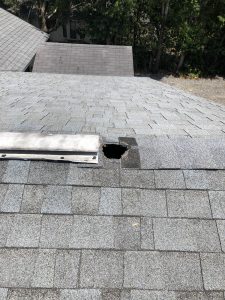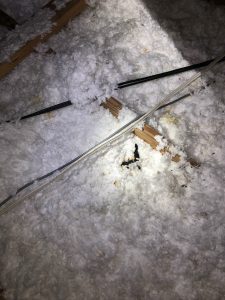Raccoon Removal from your attic or property

Raccoon removal from roof
Raccoons are, in most cases, nocturnal. When inside your attic, they leave large trails within the insulation, leave larger droppings, somewhat similar to a dog’s, and in most cases leave some form of damage to their entry point that can be viewed from the outside. Raccoons are often heard between the hours of 11pm and 4am. Mother raccoons are very quiet and may be inside the attic for several months before you hear any activity, they often have 3-5 babies in the attic area which need to either be removed and rehomed by the mother or manually extracted and transported to a licensed Wildlife Rehabilitator. Typically when you start hearing the loud thumping and fighting noises the kits are several months old and may have already caused a significant amount of damage.

Raccoon in attic
Raccoon removal from roof
A major cause of home and attic damage, raccoons in Florida are always on the lookout for a great place to live, hunt, or raise their young, and your attic is just right. Attics provide a dry, warm, safe shelter for raccoons. Raccoons enter your home by prying open areas in soffits, vents or other vulnerable spots and once inside the damage begins. Destruction of duct work, insulation, wiring, plumbing and wood often takes place leaving a high likelihood of possible flood or fire. Combined with damage to personal sometimes irreplaceable belongings stored in the attic. Your attic area has also become an indoor toilet for your new tenants who leave behind urine and droppings. Parasites such as fleas can also be a problem long after the raccoon family has been removed.

Raccoon Trapped on Roof
Raccoon Removal Services
AWR offers fully humane options to remove nuisance raccoons from your attic or interior of home or businesses. In addition, we also offer trapping and deterrent services for clients experiencing issues with wild raccoons outside or around their property. Oftentimes, Raccoons will frequent bird feeders, swimming pools, flower beds and many other outdoor sources of food or hydration, contaminating these areas and frequently causing damage as well. We can safely remove and relocate these pesky critters to a more rural and remote location no less than 30 miles from place of capture. If you live in the Miami-Dade County, call (305) 742-0067.
Raccoon Exclusion Services:

Exposed hole in roof
Perhaps the most important service AWR provides is our ability to prevent animals from returning to the interior of your home or business. We accomplish this by making structural repairs or additions to remove the opportunity for animals to enter a building. Homes are often built with many vulnerable places that Raccoons are keen at abusing. Roof exhaust vents are never built to a true animal proof standard, roof returns and pipe vents are also examples of commonly exploited areas by nuisance wildlife. AWR seals these areas with lifetime materials, expanded metals, stainless steel hardware and concrete would be examples of materials you would expect to see applied to your building. AWR focuses on not only sealing these areas but making sure everything is aesthetically pleasing to the homeowner and development ensuring a complete service without altering the visually pleasing aspects of your home.

Raccoon feces

feces odor
Raccoon odor treatment and Bioremediation
Every exclusion project is completed by odor treatments and bioremediation, AWR has several weapons at their disposal. AWR relies on several different methods of odor control. Scent bombs help to mask and neutralize fresh odors. Hydroxyl Generators clean the air and provide hydrogen particles into the atmosphere to clean uncleanable areas. AWR’s Bioremediation process neutralizes all negative bacterias in the area, not only negating latreens and birthing areas but also destroying any bacterias left behind by food items, by neutralizing these “scent markers” we remove the desire for any nuisance wildlife to return in the future. Common bacteria found in attic spaces with nuisance wildlife issues include, histoplasmosis, leptospirosis, salmonella, hanta virus and many more. This process is a must to insure no future issues arise.
